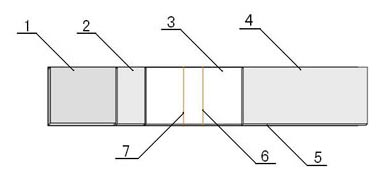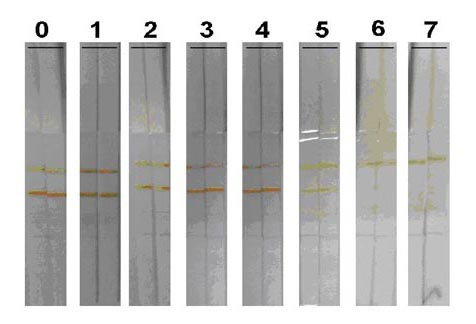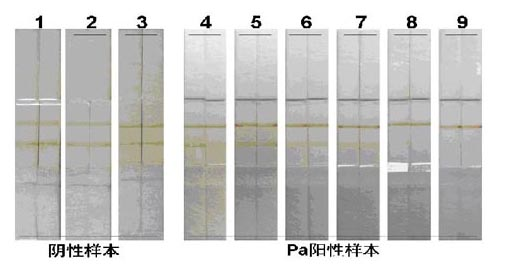Rapid immunomagnetic bead chromatographic method for main allergens in aquatic products
A main allergen and rapid immunization technology, applied in the field of food allergen detection methods, to achieve strong specificity, easy operation, and high sensitivity
- Summary
- Abstract
- Description
- Claims
- Application Information
AI Technical Summary
Problems solved by technology
Method used
Image
Examples
preparation example Construction
[0051] The preparation method of the specific nanometer detection probe is:
[0052] A. Take an appropriate amount of carboxyl magnetic beads into a centrifuge tube, use 500μL 0.01M MEST solution containing 0.5% (v / v) Tween-20, pH5.0 as the activation buffer solution to wash the magnetic beads, and place the centrifuge tube on the magnetic separation rack Make the magnetic beads separate from the activation solution, repeat the washing several times, and finally resuspend the magnetic beads;
[0053] B. Then add freshly prepared 2.6M carbodiimide (EDC) and 2.2M N-hydroxysuccinyl
[0054] Add imine (NHS) to the magnetic bead suspension to activate the carboxyl group for 30 minutes, then wash the magnetic beads with MEST buffer; then wash the magnetic beads twice with 0.005M borate Tween (abbreviated as BST) solution as the coupling buffer;
[0055] C, add parvalbumin monoclonal antibody subsequently, react 3h on the rotary mixer;
[0056] D. Then use 1% w / v BSA solution (BSA ...
Embodiment 1
[0065] Embodiment 1: Preparation of the main allergen Tm rapid detection test strip of aquatic products
[0066] In this embodiment, Tm is used as the detection object, and magnetic nanoparticles (particle size: 200nm) modified with carboxyl groups on the surface are selected. The Tm that can detect crustacean edible aquatic organisms such as shrimp, crab and clam can also be used to detect conch, abalone, The mouse monoclonal specific reaction to Tm allergens in edible aquatic organisms such as squid and octopus was used to prepare specific probes for Tm allergens in seafood, and the detection line was designed using the competitive reaction principle.
[0067] (1) Preparation of specific nano-detection probes for allergen Tm
[0068] EDC / NHS coupling
[0069] The Tm-specific monoclonal antibody was coupled with carboxyl-modified nano magnetic beads (particle size: 200nm) to prepare immunomagnetic beads containing Tm monoclonal antibody, that is, Tm magnetically label...
Embodiment 2
[0079] Embodiment 2: Preparation of the main allergen Pa rapid detection test strip of aquatic products
[0080] In this example, Pa is used as the detection object, and magnetic nanoparticles (particle size: 100nm) modified with carboxyl groups on the surface are selected, combined with those that have specific reactions to parvalbumin in fish and Pa in vertebrates such as frogs, rats, and turtles. Murine monoclonal antibodies were used to prepare specific nanoprobes for the main fish allergen Pa, and then the detection line was designed using the competitive reaction principle.
[0081] (1) Preparation of specific nanoprobes for allergen Pa
[0082] EDC / NHS coupling
[0083] Coupling the parvalbumin monoclonal antibody with carboxyl-modified nano-magnetic beads to prepare immunomagnetic beads containing parvalbumin monoclonal antibody, that is, parvalbumin magnetic-labeled antibody. Use MEST solution (0.05% Tween-20) at pH 5.0 as the activation buffer solution, take...
PUM
| Property | Measurement | Unit |
|---|---|---|
| Particle size | aaaaa | aaaaa |
| Particle size | aaaaa | aaaaa |
| Particle size | aaaaa | aaaaa |
Abstract
Description
Claims
Application Information
 Login to View More
Login to View More - R&D
- Intellectual Property
- Life Sciences
- Materials
- Tech Scout
- Unparalleled Data Quality
- Higher Quality Content
- 60% Fewer Hallucinations
Browse by: Latest US Patents, China's latest patents, Technical Efficacy Thesaurus, Application Domain, Technology Topic, Popular Technical Reports.
© 2025 PatSnap. All rights reserved.Legal|Privacy policy|Modern Slavery Act Transparency Statement|Sitemap|About US| Contact US: help@patsnap.com



